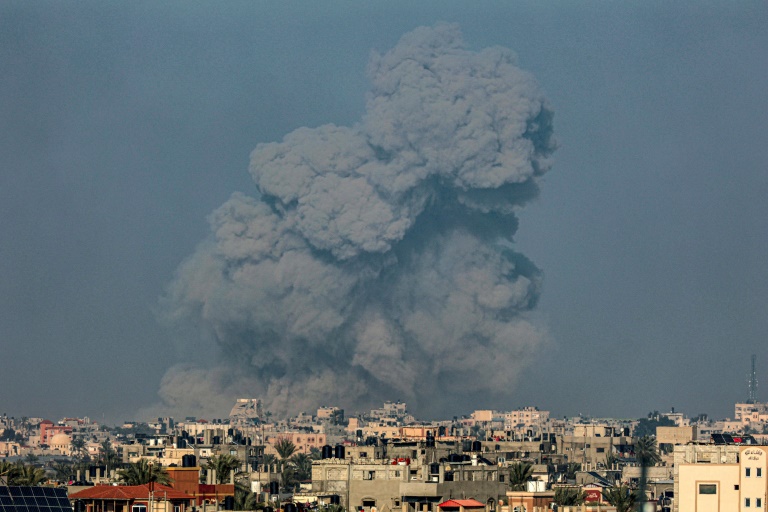
Israel intensified its attacks in the southern Gaza Strip on Saturday after Prime Minister Benjamin Netanyahu and US President Joe Biden discussed differences over the post-war future of the Palestinians that signal a rift between the two allies.
Witnesses said that Israeli bombing focused again during the night on Khan Yunis, the largest city in the southern Gaza Strip, which is controlled by Hamas, although Palestinian media also reported heavy gunfire around Jabalia in the north early on Saturday.
Biden and Netanyahu held their first phone call since December 23, a day after the Israeli leader reiterated his rejection of any form of Palestinian sovereignty, deepening divisions with Israel's main backer over the war.
While the two leaders talked about what might happen next, the reality of war was very clear in Khan Yunis and elsewhere in Hamas-controlled territory.
A bloodied child cried on a stretcher in Al-Nasr Hospital in Khan Yunis, while ambulances carrying the wounded and dead arrived to the sound of automatic weapons in the distance.
The conflict began with unprecedented attacks launched by Hamas, which resulted in the deaths of about 1,140 people in Israel, most of them civilians, according to a tally prepared by Agence France-Presse based on official Israeli figures.
Israel has vowed to destroy Hamas in response, and its air and ground offensive has killed at least 24,762 Palestinians, about 70 percent of them women, young children and teenagers, according to the Hamas-run health ministry in Gaza.
Netanyahu said that Israel expects the war to continue for several months, but his statements on Thursday rejecting the so-called two-state solution indicate a disagreement with the United States, the main backer.
Biden said after a call on Friday with Netanyahu, with whom he has had a complex relationship for nearly 40 years, that it was possible that the Israeli leader would come.
“There are a number of types of two-state solutions,” Biden told reporters after an event at the White House. “There are a number of UN member states… that don’t have their own militaries.”
“So, I think there are ways this can work.”
Netanyahu said on Thursday that Israel “must have security control over the entire territory west of the Jordan River,” which “contradicts the idea of (Palestinian) sovereignty.”
US Secretary of State Anthony Blinken had said in Davos a day earlier that Israel could not achieve “real security” without “a path leading to a Palestinian state.”
– Famine and disease –
Biden has stood firmly behind Israel since the October 7 attacks by Hamas, although he has also warned that Israel could lose support due to “indiscriminate bombing” in Gaza.
The United Nations says the war has displaced about 85 percent of Gaza's population and warns that there is an urgent need to improve aid access as famine and disease approach.
The White House also said after Friday's call that Israel would allow flour to be shipped to the Palestinians through the port of Ashdod.
The United Nations Children's Fund (UNICEF) said on Friday that about 20,000 children were born “in hell” in the Gaza Strip since the start of the Israeli attack.
A week-long communications outage in Gaza exacerbated the challenges, although the Communications Ministry and Paltel said internet services began returning on Friday.
The Israeli military offensive moved south into Gaza as the conflict progressed.
Mutawa Nabil, who was recently released by Israeli forces and bears scars on his arms, told AFP that he fled Beit Lahia in northern Gaza “to face death” in the destroyed southern city of Rafah near the Egyptian border.
Some residents who fled the early stages of the war in northern Gaza have begun returning to what remains of their homes.
In the Rimal neighborhood in Gaza City, “everything is destroyed and people are dying of hunger,” said Ibrahim Saada, who told AFP that he lost his entire family.
Groups of isolated fighters are still confronting forces in northern Gaza, despite the Israeli army saying this month that Hamas' fighting structures in the north had been dismantled.
– Hostage video released –
The militants also took about 250 hostages during the October 7 attacks, of whom Israel says about 132 are still in Gaza.
It is believed that at least 27 hostages were killed, according to a tally prepared by Agence France-Presse based on Israeli figures.
The Islamic Resistance Movement (Hamas) in Gaza broadcast a video on Friday showing an Israeli hostage it said was killed in an Israeli raid.
The video was undated and its authenticity could not be independently verified.
– Houthi missiles –
The Gaza war has spread to the surrounding areas
The region, where Iranian-aligned groups launch attacks and regularly exchange cross-border fire between Israeli forces and the Lebanese Hezbollah movement.
The Israeli army said on Friday that it struck Hezbollah sites and infrastructure in southern Lebanon and intercepted a drone that crossed from Lebanon into the Israeli maritime zone.
The Lebanese National News Agency said that Israeli aircraft destroyed three homes in the village of Kafr Kila. Hezbollah claimed three attacks against Israeli sites.
Violence has also escalated in the occupied West Bank, where Israeli forces and settlers have killed more than 360 people since October 7, according to the Palestinian Ministry of Health.
The Palestinian Wafa News Agency reported that a 17-year-old Palestinian youth was killed by Israeli fire in Al-Mazraa Al-Sharqiya, east of Ramallah.
Attacks by Yemen's Houthi rebels on ships in the Red Sea in support of Palestinians in Gaza have prompted retaliatory strikes by US and British forces, raising fears of a wider escalation.
bur-imm/pbt/mtp

